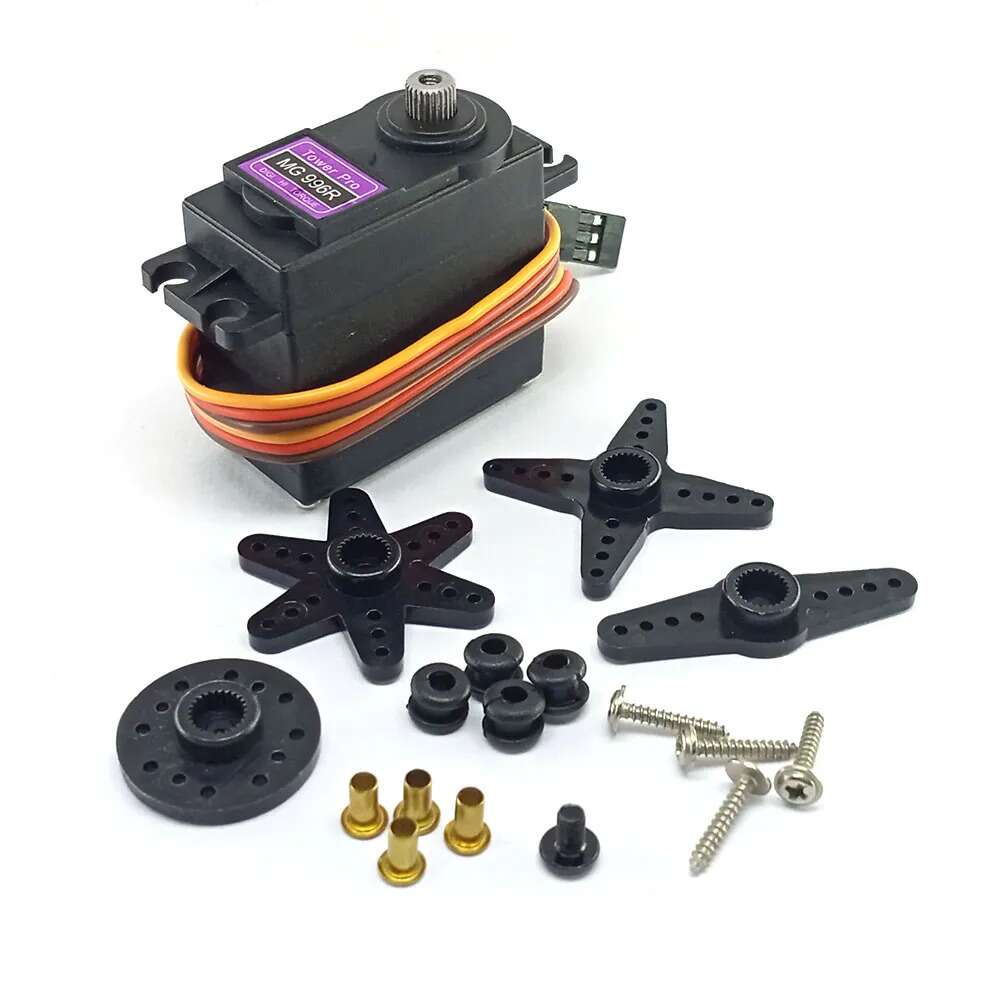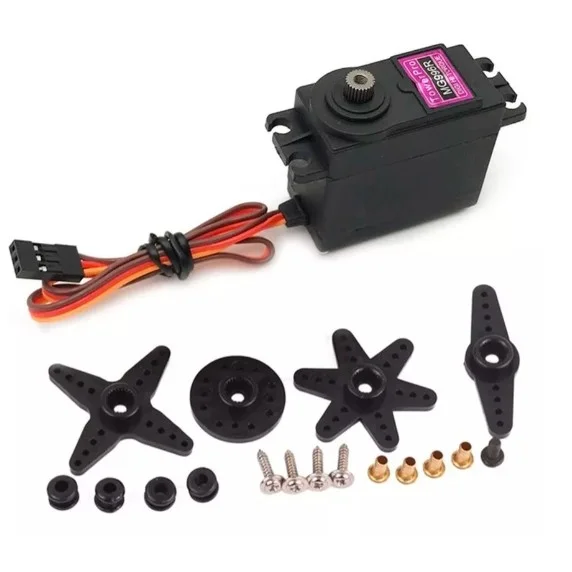Description
The Servo Motor MG996 is a standard-size servo with a range of 180 degrees good torque and moderate speed.
Package Includes:
- Qty 1 – MG996 Servo motor
- Qty 4 – Arms/horns for various interface applications
- Qty 5 – Screws for mounting
- Qty 4 – Rubber and brass bushings for mounting
Key Features of Servo Motor MG996R 180-degree :
- Standard (medium) size servo
- High torque of up to 13kg/cm
- 180-degree rotation
- Half metal gears (Metal + Plastic)
- Analog drive
These servos have good torque for the cost and work well for experimenting with robotic arms, steering controls, and other applications that require a fair amount of grunt. The MG996 has a little more torque than the otherwise very similar MG995.
The high torque capability comes at the expense of fast speed of movement due to the gearing. A 60° rotation takes about 0.2 seconds. That is fine for robotic arm movement or slower speed crawler steering for instance, but too slow for a fast-moving RC car or flight controls.
Servo motors can be commanded to go to a specific position and are the usual go-to motor when accurate positioning is needed, such as for turning the front wheels on an RC model for steering or pivoting a sensor to look around on a robotic vehicle.
Servo motors are comprised of a DC motor, gears, a potentiometer to determine its position, and a small electronic control board.
Servos usually have a specified limited range. This is usually specified as 180 degrees. Frequently the actual range is not quite the full 180 degrees and is limited by the mechanical gears and potentiometer used for position sensing that is contained in the device. If the motor is run all the way to 0 or 180, it may start making unhappy sounds and start vibrating as it tries to drive to a position that it cannot get to. This causes a high stall current condition and has the potential of stripping gears and eventually burning out the drive electronics or damaging the motor, so it is best to either drive it to a safely reduced range such as 20-160, or experiment with a bit to determine the actual usable range if you want to maximize the range.
Some versions of the servo may be specified as 360-degree continuous rotation. In this case, the servo mechanical stops and potentiometer have been removed or disconnected and are designed to rotate continuously in either direction and are primarily used for driving wheels.
Servos expect to see a pulse on their PWM pin every 20mSec (50Hz). The pulse is active HIGH and the width of the pulse determines the position (angle) of the servos shaft. The pulse can vary between 1mSec and 2mSec. A 1mSec pulse positions the shaft at 0 degrees. A 1.5mSec pulse positions the shaft at 90 degrees (centered in its range). A 2mSec pulse positions the shaft at 180 degrees. Pulses with values between these can be used to position the shaft arbitrarily.
Motor Connections
The built-in cable has a 3-pin female connector that is usually mated with a male header.

1×3 Connector
- Brown = Ground
- Red = 5V
- Orange = PWM Signal
Technical Specifications
| Motor Model | Generic MG996 (China) | |
| Drive Type | Analog | |
| Degree Rotation | 180° (±10°) | |
| Operating Ratings | ||
| Voltage | 4.8-6VDC (5V Typical) | |
| Current (idle) | 10mA (typical) | |
| Current (typical during movement) | 170-400mA | |
| Current (stall) | 1.3 – 1.5A (measured) | |
| Stall Torque | 13kg-cm (typical) | |
| Speed | 0.2s / 60 degree (varies with VDC) | |
| Dimensions | ||
| Cable Length | 29cm | |
| Motor Housing L x W x H | 40.9 x 20 x 39mm | |
| Motor Height (w/ shaft) | 45mm | |
| Motor Housing Width with Mounting Ears | 54mm |








Reviews
There are no reviews yet.